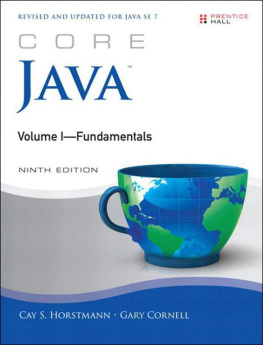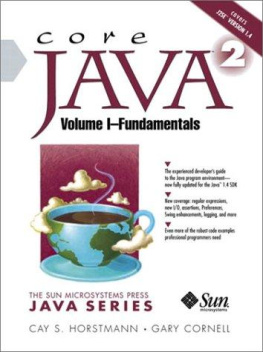About This E-Book
EPUB is an open, industry-standard format for e-books. However, support for EPUB and its many features varies across reading devices and applications. Use your device or app settings to customize the presentation to your liking. Settings that you can customize often include font, font size, single or double column, landscape or portrait mode, and figures that you can click or tap to enlarge. For additional information about the settings and features on your reading device or app, visit the device manufacturers Web site.
Many titles include programming code or configuration examples. To optimize the presentation of these elements, view the e-book in single-column, landscape mode and adjust the font size to the smallest setting. In addition to presenting code and configurations in the reflowable text format, we have included images of the code that mimic the presentation found in the print book; therefore, where the reflowable format may compromise the presentation of the code listing, you will see a Click here to view code image link. Click the link to view the print-fidelity code image. To return to the previous page viewed, click the Back button on your device or app.
Core Java
Volume IFundamentals
Tenth Edition
Cay S. Horstmann

Boston Columbus Indianapolis New York San Francisco Amsterdam Cape Town
Dubai London Madrid Milan Munich Paris Montreal Toronto Delhi Mexico City
Sao Paulo Sidney Hong Kong Seoul Singapore Taipei Tokyo
The author and publisher have taken care in the preparation of this book, but make no expressed or implied warranty of any kind and assume no responsibility for errors or omissions. No liability is assumed for incidental or consequential damages in connection with or arising out of the use of the information or programs contained herein.
For information about buying this title in bulk quantities, or for special sales opportunities (which may include electronic versions; custom cover designs; and content particular to your business, training goals, marketing focus, or branding interests), please contact our corporate sales department at or (800) 382-3419.
For government sales inquiries, please contact .
For questions about sales outside the United States, please contact .
Visit us on the Web: informit.com/ph
Library of Congress Cataloging-in-Publication Data
Names: Horstmann, Cay S., 1959- author.
Title: Core Java / Cay S. Horstmann.
Description: Tenth edition. | New York : Prentice Hall, [2016] | Includes
index.
Identifiers: LCCN 2015038763| ISBN 9780134177304 (volume 1 : pbk. : alk.
paper) | ISBN 0134177304 (volume 1 : pbk. : alk. paper)
Subjects: LCSH: Java (Computer program language)
Classification: LCC QA76.73.J38 H6753 2016 | DDC 005.13/3dc23
LC record available at http://lccn.loc.gov/2015038763
Copyright 2016 Oracle and/or its affiliates. All rights reserved.
500 Oracle Parkway, Redwood Shores, CA 94065
Portions Cay S. Horstmann
All rights reserved. Printed in the United States of America. This publication is protected by copyright, and permission must be obtained from the publisher prior to any prohibited reproduction, storage in a retrieval system, or transmission in any form or by any means, electronic, mechanical, photocopying, recording, or likewise. For information regarding permissions, request forms and the appropriate contacts within the Pearson Education Global Rights & Permissions Department, please visit www.pearsoned.com/permissions/.
Oracle America Inc. does not make any representations or warranties as to the accuracy, adequacy or completeness of any information contained in this work, and is not responsible for any errors or omissions.
ISBN-13: 978-0-13-417730-4
ISBN-10: 0-13-417730-4
Text printed in the United States on recycled paper at RR Donnelley in Crawfordsville, Indiana.
First printing, December 2015
Preface
To the Reader
In late 1995, the Java programming language burst onto the Internet scene and gained instant celebrity status. The promise of Java technology was that it would become the universal glue that connects users with information wherever it comes fromweb servers, databases, information providers, or any other imaginable source. Indeed, Java is in a unique position to fulfill this promise. It is an extremely solidly engineered language that has gained wide acceptance. Its built-in security and safety features are reassuring both to programmers and to the users of Java programs. Java has built-in support for advanced programming tasks, such as network programming, database connectivity, and concurrency.
Since 1995, nine major revisions of the Java Development Kit have been released. Over the course of the last 20 years, the Application Programming Interface (API) has grown from about 200 to over 4,000 classes. The API now spans such diverse areas as user interface construction, database management, internationalization, security, and XML processing.
The book you have in your hands is the first volume of the tenth edition of Core Java. Each edition closely followed a release of the Java Development Kit, and each time, we rewrote the book to take advantage of the newest Java features. This edition has been updated to reflect the features of Java Standard Edition (SE) 8.
As with the previous editions of this book, we still target serious programmers who want to put Java to work on real projects. We think of you, our reader, as a programmer with a solid background in a programming language other than Java, and we assume that you dont like books filled with toy examples (such as toasters, zoo animals, or nervous text). You wont find any of these in our book. Our goal is to enable you to fully understand the Java language and library, not to give you an illusion of understanding.
In this book you will find lots of sample code demonstrating almost every language and library feature that we discuss. We keep the sample programs purposefully simple to focus on the major points, but, for the most part, they arent fake and they dont cut corners. They should make good starting points for your own code.
We assume you are willing, even eager, to learn about all the advanced features that Java puts at your disposal. For example, we give you a detailed treatment of
Object-oriented programming
Reflection and proxies
Interfaces and inner classes
Exception handling
Generic programming
The collections framework
The event listener model
Graphical user interface design with the Swing UI toolkit
Concurrency
With the explosive growth of the Java class library, a one-volume treatment of all the features of Java that serious programmers need to know is no longer possible. Hence, we decided to break up the book into two volumes. The first volume, which you hold in your hands, concentrates on the fundamental concepts of the Java language, along with the basics of user-interface programming. The second volume, Core Java, Volume IIAdvanced Features, goes further into the enterprise features and advanced user-interface programming. It includes detailed discussions of
The Stream API
File processing and regular expressions
Databases
XML processing
Annotations
Internationalization
Network programming
Advanced GUI components
Advanced graphics
Native methods
When writing a book, errors and inaccuracies are inevitable. Wed very much like to know about them. But, of course, wed prefer to learn about each of them only once. We have put up a list of frequently asked questions, bug fixes, and workarounds on a web page at






